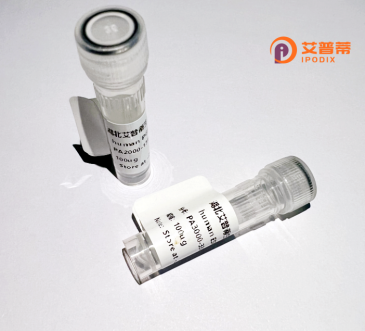
| 纯度 | >90%SDS-PAGE. |
| 种属 | Human |
| 靶点 | CNOT1 |
| Uniprot No | A5YKK6 |
| 内毒素 | < 0.01EU/μg |
| 表达宿主 | E.coli |
| 表达区间 | 2278-2375aa |
| 氨基酸序列 | NSHTHYFSCTMLYLFAEANTEAIQEQITRVLLERLIVNRPHPWGLLITFIELIKNPAFKFWNHEFVHCAPEIEKLFQSVAQCCMGQKQAQQVMEGTGA |
| 分子量 | 36.52 kDa |
| 蛋白标签 | GST-tag at N-terminal |
| 缓冲液 | 0 |
| 稳定性 & 储存条件 | Lyophilized protein should be stored at ≤ -20°C, stable for one year after receipt. Reconstituted protein solution can be stored at 2-8°C for 2-7 days. Aliquots of reconstituted samples are stable at ≤ -20°C for 3 months. |
| 复溶 | Always centrifuge tubes before opening.Do not mix by vortex or pipetting. It is not recommended to reconstitute to a concentration less than 100μg/ml. Dissolve the lyophilized protein in distilled water. Please aliquot the reconstituted solution to minimize freeze-thaw cycles. |
以下是关于重组人CNOT1蛋白的3篇参考文献及其摘要概括:
---
1. **文献名称**:*Structural and functional analysis of the human CCR4-NOT deadenylase complex*
**作者**:Chen, Y., Boland, A., Kuzuoğlu-Öztürk, D., et al.
**摘要**:通过冷冻电镜解析人源CCR4-NOT复合物的结构,发现CNOT1作为支架蛋白对复合物组装的关键作用,并阐明其在mRNA去腺苷化及基因表达调控中的分子机制。
---
2. **文献名称**:*Reconstitution of recombinant human CNOT1 reveals its role in microRNA-mediated gene silencing*
**作者**:Mathys, H., Basquin, J., Ozgur, S., et al.
**摘要**:利用重组人CNOT1蛋白与CNOT7、CNOT8等亚基重构复合物,揭示CNOT1通过结合Argonaute蛋白参与miRNA介导的基因沉默通路。
---
3. **文献名称**:*The scaffolding protein CNOT1 coordinates transcription and decay of mRNA targets*
**作者**:Mauxion, F., Preve, B., Séraphin, B.
**摘要**:研究通过表达重组CNOT1突变体,证明其连接转录调控因子(如NR4A1)与mRNA降解机制的双重功能,协调基因表达的动态平衡。
---
这些研究涵盖CNOT1的结构、功能及在基因调控网络中的核心作用,可通过PubMed或期刊官网进一步获取全文。
The human CNOT1 protein is a critical scaffold component of the CCR4-NOT complex, a multi-subunit machinery involved in post-transcriptional gene regulation. This complex plays diverse roles in mRNA degradation, translational repression, and miRNA-mediated regulation, impacting cellular processes such as development, metabolism, and stress responses. CNOT1 serves as the structural backbone, binding other subunits (e.g., CNOT2/3. CNOT6/6L/7) and recruiting deadenylases or RNA-binding proteins. Recombinant human CNOT1 is typically expressed in vitro using systems like mammalian cells or *E. coli* to study its molecular interactions and mechanisms. Structural analyses reveal conserved domains, including NOT1-specific regions for partner binding and a C-terminal module for nucleic acid interactions. Dysregulation of CNOT1 is linked to cancers, neurodegenerative diseases, and viral infections, highlighting its therapeutic potential. Recombinant CNOT1 enables biochemical assays (e.g., protein-RNA binding, enzymatic activity), structural studies (X-ray crystallography, cryo-EM), and drug screening. Research on recombinant CNOT1 advances understanding of post-transcriptional control networks and disease pathogenesis, offering insights for targeted therapies.
×